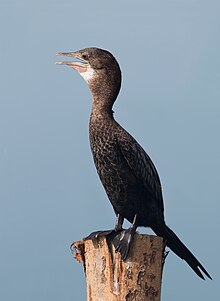Little cormorant
| Little cormorant | |
|---|---|
 |
|
| In non-breeding plumage. Note whitish throat patch and brownish plumage. | |
| Scientific classification | |
| Kingdom: | Animalia |
| Phylum: | Chordata |
| Class: | Aves |
| Order: | Suliformes |
| Family: | Phalacrocoracidae |
| Genus: | Microcarbo |
| Species: | M. niger |
| Binomial name | |
|
Microcarbo niger (Vieillot, 1817) |
|
| Synonyms | |
|
Halietor niger |
|
| Measurements | |||
|---|---|---|---|
| India | |||
| Length | 420–455 mm (16.5–17.9 in) | ||
| 415–435 mm (16.3–17.1 in) | |||
| Tail | 137–150 mm (5.4–5.9 in) | ||
| 125–140 mm (4.9–5.5 in) | |||
| Head | 79–82 mm (3.1–3.2 in) | ||
| 76–77 mm (3.0–3.0 in) | |||
Halietor niger
Phalacrocorax niger
Phalacrocorax javanicus
The little cormorant (Microcarbo niger) is a member of the cormorant family of seabirds. Slightly smaller than the Indian cormorant it lacks a peaked head and has a shorter beak. It is widely distributed across the Indian Subcontinent and extends east to Java, where it is sometimes called the Javanese cormorant. It forages singly or sometimes in loose groups in lowland freshwater bodies, including small ponds, large lakes, streams and sometimes coastal estuaries. Like other cormorants, it is often found perched on a waterside rock with its wings spread out after coming out of the water. The entire body is black in the breeding season but the plumage is brownish, and the throat has a small whitish patch in the non-breeding season. These birds breed in trees, often joining other waterbirds at heronries.
The little cormorant is about 50 centimetres (20 in) long and only slightly smaller than the Indian cormorant (Phalacrocorax fuscicollis). The Indian cormorant has a narrower and longer bill which ends in a prominent hook tip, blue iris and a more pointed head profile. The breeding adult bird has a glistening all black plumage with some white spots and filoplumes on the face. There is also a short crest on the back of the head. The eyes, gular skin and face are dark. In the non-breeding bird or juvenile, the plumage is brownish and the bill and gular skin can appear more fleshy. The crest becomes inconspicuous and a small and well-marked white patch on the throat is sometimes visible. Towards the west of the Indus River valley, its range can overlap with vagrant pygmy cormorants (Microcarbo pygmaeus), which can be difficult to differentiate in the field and are sometimes even considered conspecific. The sexes are indistinguishable in the field, but males tend to be larger. Some abnormal silvery-grey plumages have been described.
The species was described by Vieillot in 1817 as Hydrocorax niger. The genus Hydrocorax literally means water crow. It was later included with the other cormorants in the genus Phalacrocorax but some studies place the smaller "microcormorants" under the genus Microcarbo.
...
Wikipedia

